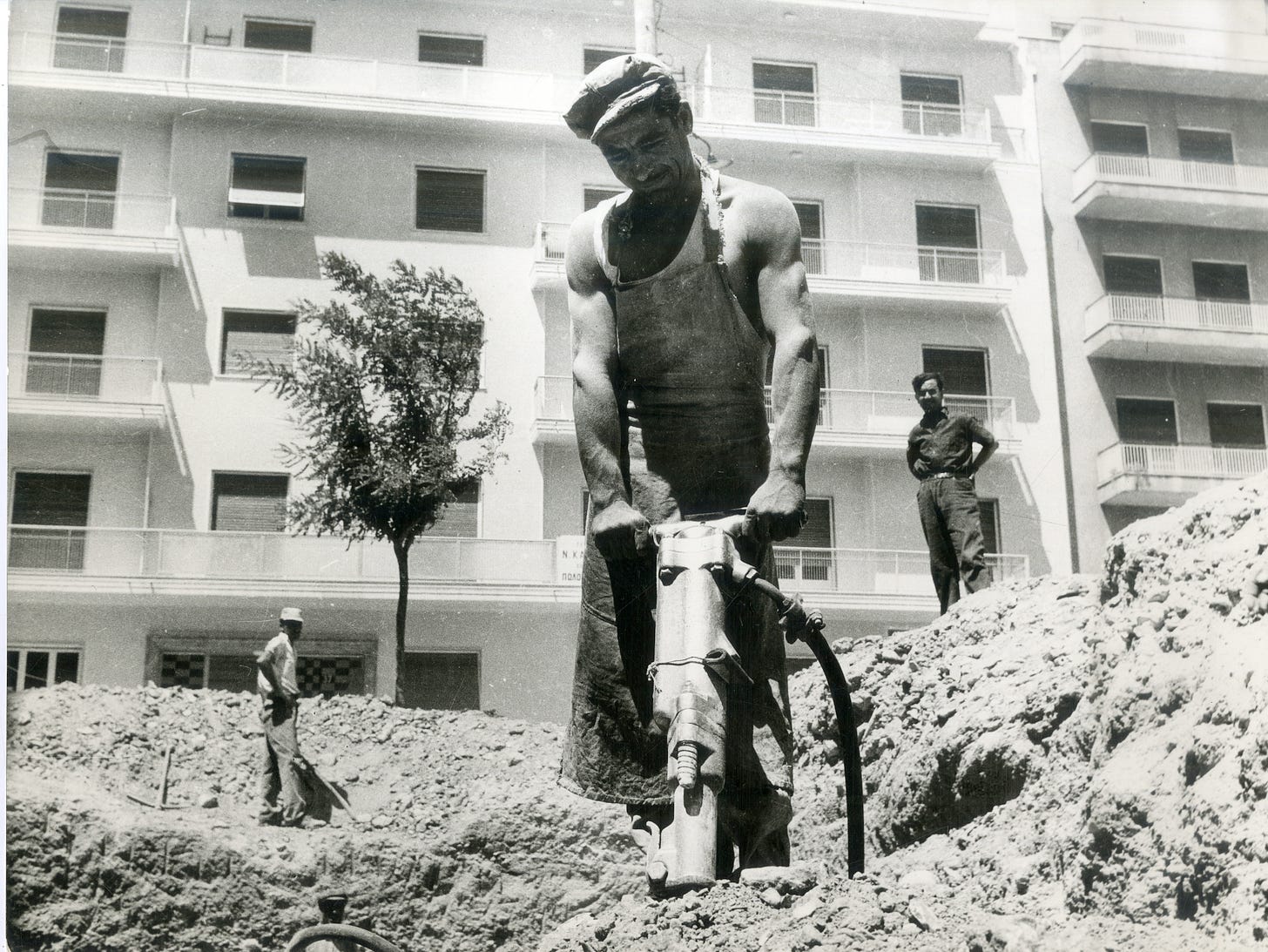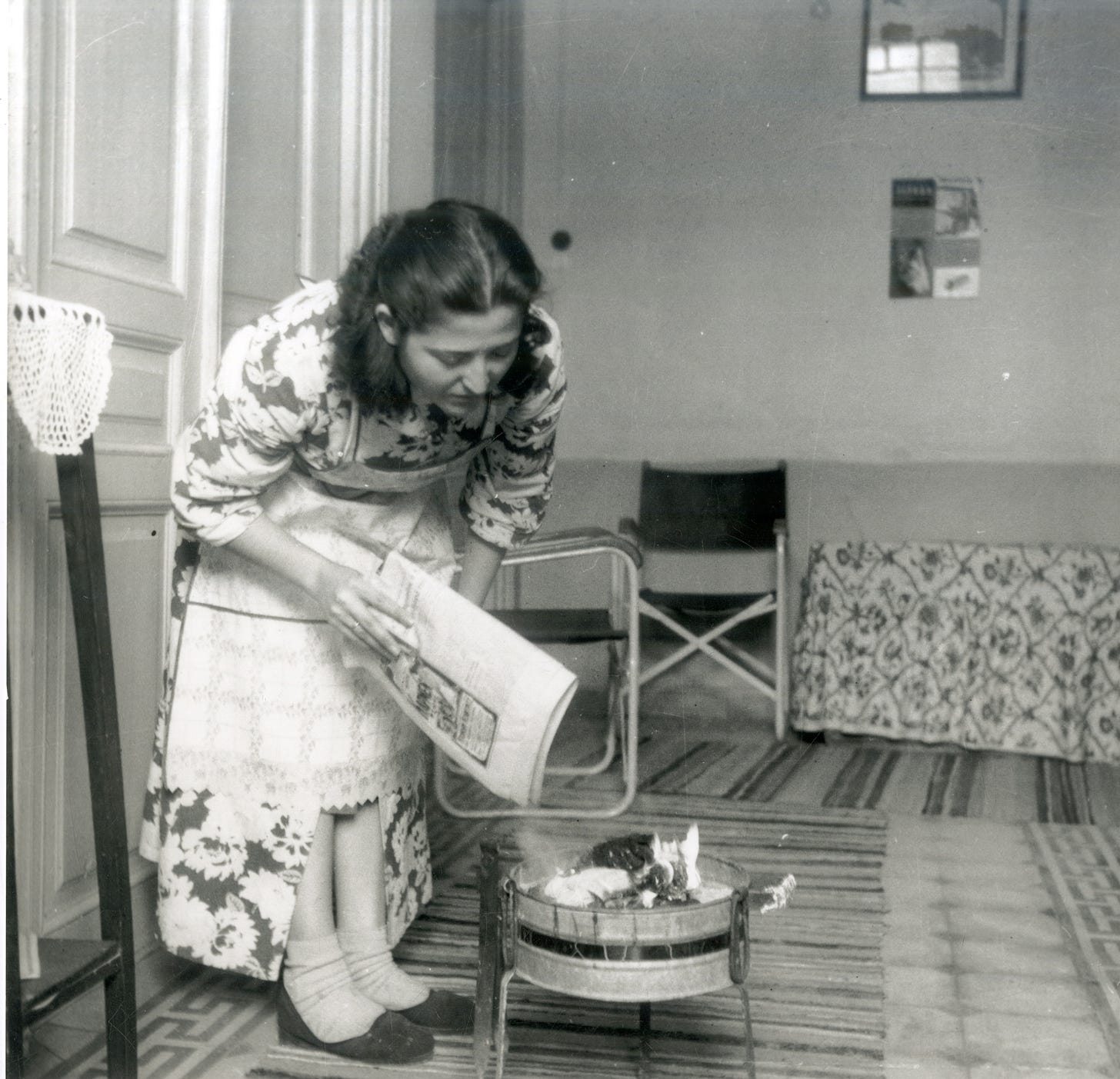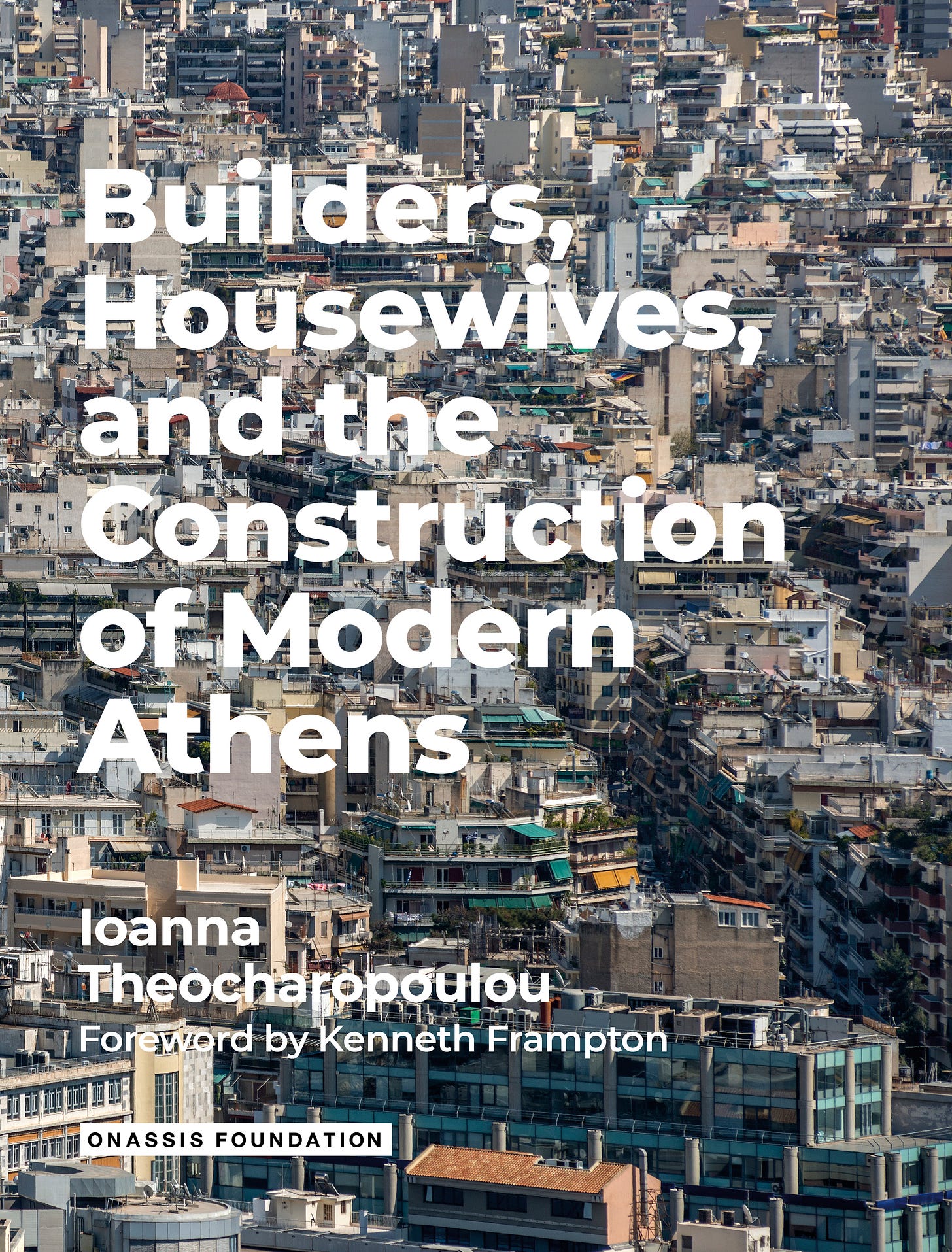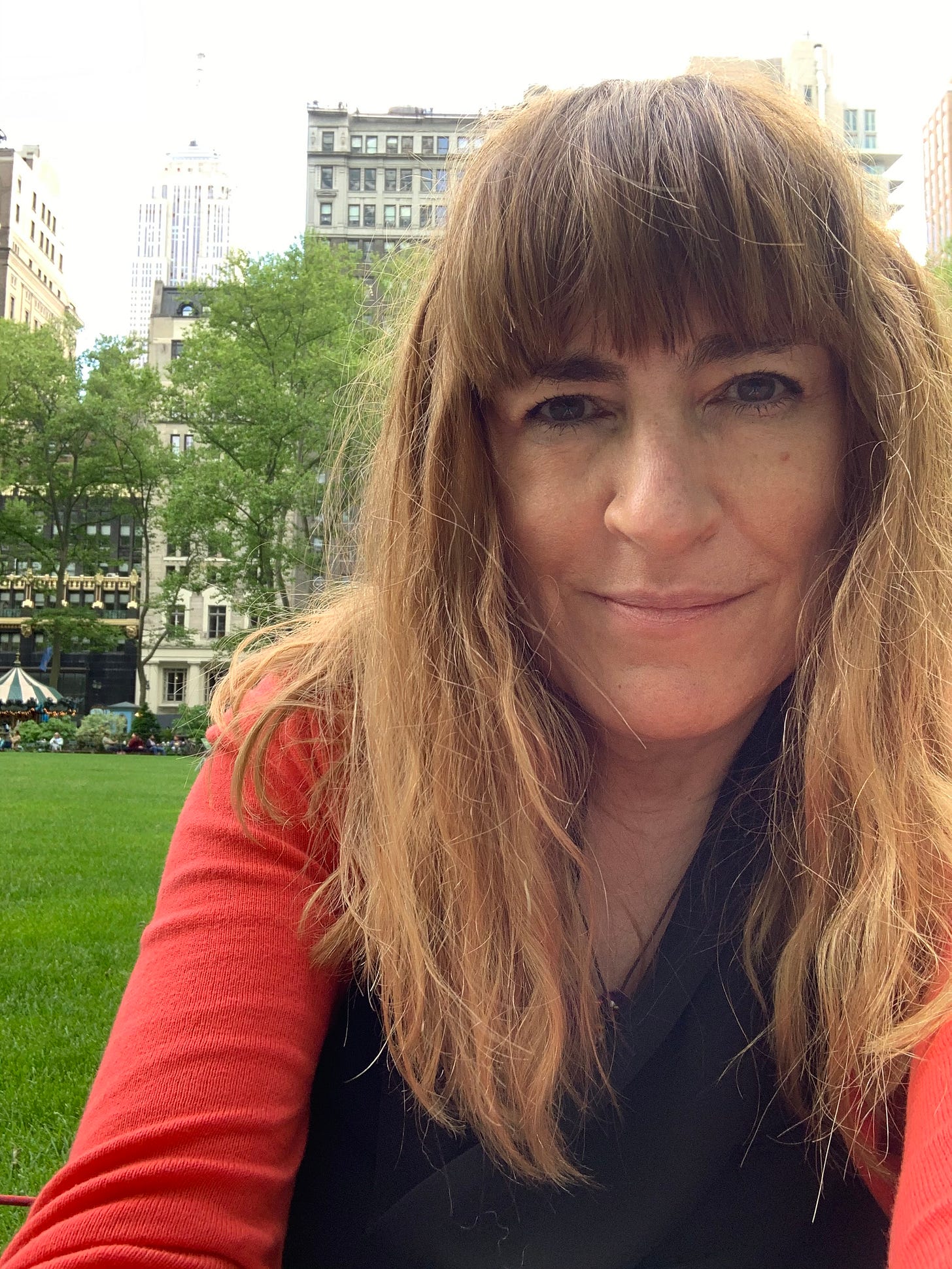Ioanna Theocharopoulou on "Builders, Housewives, and the Construction of Modern Athens"
The inspiration for the 2021 documentary film, the book is now available in a revised edition

In each installment of “The Usonian Interviews,” The Usonian spotlights a storyteller from a different corner of the globe. This week, The Usonian spoke with architect and architectural historian Ioanna Theocharopoulou about her book Builders, Housewives, and the Construction of Modern Athens, recently republished by the Onassis Foundation alongside a Greek-language edition. You can order the book here.
The book served as the inspiration for the 2021 documentary film of the same name, written and directed by Giannis Gaitanidis and Tassos Langis.
This interview has been edited for clarity and length. The views presented by the interview subject are the opinions of the subject and do not represent the views of the author or this newsletter. Browse the full interview archive here.
THE USONIAN: Your book tells the story of how polykatoikia, a Greek style of modernist apartment complex, came to dominate Athens after World War II. How did you become interested in this subject? What do polykatoikia represent in the history of architecture?
IOANNA THEOCHAROPOULOU: I was born in Athens, and lived there until I was 12. My father was raised in Theseion and I heard stories about life in Athens during the Second World War since I was little. I decided to write about Athens for my doctoral dissertation rather than focus on an individual architect. Once I started gathering historical material, I found that there was a pervasive cynicism about the city, a feeling that there was something abhorrent about it. A negativity regarding Athenian urbanism is evident to this day. For example, in a post in the Los Angeles Review of Books from 2013, Greek poet Stephanos Papadopoulos, said “elegant neoclassical Athens was bulldozed in the 1950s for the concrete hell of apartment boxes whose design is the aesthetic equivalent of a garbage dumpster.”
That sums up the usual critique of Athens. I became intrigued with this pervasive scorn and negativity. What was so dreadful, even wrong about Athens? How could I write about a city that even though is ostensibly “European,” in many ways it is also “informal,” a characteristic architectural historians usually assign to the so-called developing world?
There were some striking exceptions to the typical disapproving assessments, such as a piece by anthropologist Peter Allen discussing the positive aspects of Greek urbanization up until the 1980s in the journal Ekistics. Allen’s analysis was based on his observations of the specific characteristics of Greek culture during the early decades of the postwar period. He noted that most rural migrants who poured into the city after the end of World War II already had familial connections with the city. For those without familial connections, new regional associations were founded in Athens to help, and to eventually support relatives back home.
Another such “positive” aspect Allen discussed was the fact that rural migrants often had small pieces of land or an old house back in their village that they could return to, and therefore had a greater sense of security and a way to finance their move. In addition, Allen pointed out that “Greece […] is a small and culturally homogenous country in which the vast majority of people speak Greek and practice Greek orthodoxy. Virtually everyone under the age of fifty is literate and the education level of most Greek migrants is substantially higher than that of the average individual migrating to the cities of Asia, Latin America, and Africa. To most Greeks the city is a familiar place where one has relatives and friends.”
There were other advantages to Greek urbanization noted by many figures, including Anastasia Tzakou (an important female architect working in the postwar period), and architectural historian Kenneth Frampton, who contributed my book’s introduction.

TU: I tend to think architectural styles age into authenticity. For example, Pueblo and Mission Revival architecture in the Southwest U.S. was a conscious effort by real estate and tourism promoters in the early 19th century to give their cities a distinct regional identity. A hundred years later, visitors are impressed by these “authentic” buildings, despite the fact that technically they are an example of historical artifice.
IT: The question of how authenticity and identity might be conveyed or even embodied in architecture raises very specific themes in the context of Greece.
One of these is the long-standing comparison between an infinitely superior classical Athens, idealized especially during the late 18th and 19th centuries by Northern European artists, architects and scholars, and the “chaotic” modern city. It’s almost as if when some visitors arrive in Athens, they still expect to see an ancient city!
But Athens has a very different relationship to its ruins than that of other European cities. Franco Purini, an Italian architect, had noted this in a short piece from 2001, where he praised Athens for not having undergone a “process of visual tasteful distancing” which for him happened in Italian cities. Instead, Purini saw a more dynamic relationship between classical ruins and the modern city, saying for instance that “even the most clumsily built” new structure, “reinforces the role of the Acropolis as the true center of the entire city”. He saw Athens as a good example of an “integration [of the classical ruins] into the world of the present day.”
TU: One dimension of your book concerns the urban growth of Athens thanks to antiparochè—the exchange of plots of land for units within a new apartment block. How did this process drive and define the urbanism of modern Athens?
IT: Up to the mid to late 1920s, Athens was a city of single or two-family houses and only a few large public buildings. The Greco-Turkish war of 1923, resulted in what is remembered in Greece as the “Asia Minor Catastrophe”: over a million people, mostly women and children, arrived destitute and traumatized in Greece almost doubling the country’s population overnight. The refugees needed housing. The government introduced a new law that encouraged “horizontal ownership,” that signaled a densification of cities, and resulted in some of the first multi-storied residential buildings called “polykatoikia” in Greek (‘poly’ [multiple] + ‘oikos’ [house]), in Athens and in other cities.
The financial system of antiparochè, which involved an exchange of a plot of land or a small 19th century dwelling with any number of apartments in a new polykatoikia building, had slowly started to appear during the late 1920s. It was a “bottom-up” system that became much more prevalent in the postwar period (it still exists today, although the stakes are totally different). In the early 1950s, there was again a huge need for housing exacerbated by the German Occupation during WWII, and the Greek Civil War (1946-1949).
Working with antiparochè meant that there was little need for large sums of cash in advance. Everyone could find employment in construction, even at a time when the Cold War prolonged the divisions of the Civil War (you had to have a certificate that you were not a communist to find work in the public sector).
Bit by bit, the modern city slowly replaced the 19th century neoclassical city.

TU: You also write of builders and their mêtis, a term that refers to a quality of cleverness, skill, and wisdom. Who were the builders of modern Athens?
IT: The builders were those who came to Athens from the countryside, looking to start a new life. After World War II and the Civil War, the countryside that was not prosperous by any means prior to the wars, was completely devastated. The men who worked in construction often had little or no formal education and relied on quasi-craft techniques. Since the scale of the polykatoikia buildings was relatively small and there was little heavy industry in Greece at the time—except cement for concrete—they were able to use their knowledge of (vernacular) building to build the polykatoikia.
This was very different than what happened in reconstruction housing projects in Northern Europe. Builders formed small teams and started to take on projects with antiparochè. Their teams were horizontally organized, and in this I see continuities with pre-Independence times, when there was a guild-like organization in construction; in those days, men traveled throughout the Balkans and other provinces of what was then the Ottoman Empire. Each region had its specialties: Epirus was known for stone workers and the Cycladic islands produced good marble-workers.
Similarly, I saw continuities between the concept of antiparochè with that of mêtis, a word from Homer, that has to do with craftiness, the ability to find ways to survive. In his book The Practice of Everyday Life, [French philosopher] Michel de Certeau wrote about mêtis and its role in Greek mythology. De Certeau pointed out that Homer’s characters were wily—Odysseus often had to use guile or a ruse to get out of a difficult situation. Referring to the work of Pierre Vernant, he described mêtis as an “extraordinarily stable characteristic of Hellenism.”
In my book I argue that the antiparochè can be seen as a bottom-up system that is based on mêtis, an oral negotiation that almost requires one to be crafty because the craftier you were, the more you could potentially gain from the exchange. I see this as a cultural characteristic potentially in continuity with survival behavior developed during foreign rule: Ottoman occupation of Greece had lasted over four centuries. As much as Greeks wanted to forget it, there were continuities.
Generally, and especially at the center of the city, the teams of builders worked with an engineer who would sign the planning permission documents. After building had begun, clients could often negotiate changes to the plans with the builders quite directly. Most architects felt left out of this process and this is perhaps another reason why their negative impressions of the city lasted for so long.
When I was doing my research in Athens, I met Nicos Valsamakis, a renowned architect who worked in the early postwar. He told me that he remembered that when he was young the head builder would sit at a little table, and clients would come and say, I want my bathroom to be this way, or that.… It was an oral negotiation for a form of craft-based building which you don’t usually associate with urban buildings.
The small plot sizes that came from the 19th century city kept the polykatoikia in a relatively small scale. There were instances where the entire polykatoikia was occupied by one family: parents, sisters, brothers, each got one floor. You could also have low-income families live on the ground floor and the higher up you went, the wealthier the residents’ status. But because they all co-inhabited the same building, there was greater social and economic diversity in the average urban neighborhood than in similar instances in Northern Europe.

TU: Your book juxtaposes scenes from classic Greek films such as ‘Η Δε Γυνή Να Φοβήται Τον Άνδρα [“Woman Shall Fear Man” (1965)] with their reflection upon the new modern world in which Athenians were building. These examples lend a lot of insight into how the construction was perceived at the time of production. What led you to these films?
IT: I mean, how rare is it that an academic book was taken out by two incredibly talented filmmakers? They came across it because they watched an online recording of a conference organized by [an architect named] Panos Dragonas at the Onassis Foundation, in which I had presented the research that eventually became the book. They tracked the book down, which was hard because it was out of print. And then we met, and Tassos and Yiannis were full of questions. They had read the book so thoroughly. I never expected anyone to read the book so closely.
It was such a gift, in a way. Two amazing, intelligent and curious people from a different discipline, were so interested in figuring out this different position to the usual sorry story about Athens. They made their own discoveries. It was a fantastic creative process. We worked closely together, but this is their project completely. [Harvard anthropologist] Michael Herzfeld, who served as the film’s narrator, called it a “friendship in concrete.”

TU: Your book concludes with a postscript reflecting on Athens in the wake of the 2008 financial crisis: “We must learn again an ancient sense of resourcefulness and wit, as well as an economy of means, so as to achieve… [the] idea of a ‘city as a form of equity,’ for which we still have a long way to go.” How have polykatoikia aged as a building type in Athens? What are their advantages and limitations as housing in the 21st century?
IT: I think that the Athenian polykatoikia, even if not particularly beautiful to look at, has aged well, not least because it was built with solid, mostly masonry materials. Its construction was of quite a high standard, certainly much better than in “shantytowns” in other rapidly industrializing areas of the world. The polykatoikia as a building type and the specific characteristics of the society and culture of that time, enabled a transformation of the rural migrants into urban dwellers, with urban aspirations in a modern way of life. This building type embodied a kind of negotiability of Greek society that crossed social layers without losing its class base.
The advantages of the dense urban building that resulted particularly in the first postwar decades, are still felt today. Athens is an incredibly vibrant city. Its small scale (never higher than 6-8 floors), allows residents a connection to the ground. The ubiquitous balconies often full of plants, encourage a less isolated interior life. The ground floors typically comprise of all kinds of mixed-use programs, from banks to restaurants, doctors’ offices, and cafes, a factor that is much desired from today’s point of view, and that contrasts sharply with rigid zoning in other large urban centers that keeps such functions separate. There are distinct historical neighborhoods that are still quite well-maintained and beautiful to walk through. Due to Athens’ mild climate, people spend a lot of time outdoors. In terms of limitations, it is critical that the small-scale family structure is not totally taken over by Airbnb and other such apps or large corporations that will likely change the whole character of the city. Airbnb was a great help to a lot of Athenians during the financial crisis, but it now needs to be tightly controlled by the government. Lastly—the city needs a lot more mature trees! But that may be another conversation.
Additional References
Allen, P., “Positive Aspects of Greek Urbanization,” Ekistics, Vol. 53 (No. 318-319), 1986, pp. 192-193.
Purini, F. “Greek Discontinuities”, in Metapolis 2001. The Contemporary Greek City”, edited by Yannis Aesopos and Yorgos Simeoforidis, Athens, Metapolis Press, 2001, page 243.
Ioanna Theocharopoulou is an architect and architectural historian whose research focuses on cities and on the histories, theories and evolving concepts of post-carbon architecture and society. She trained at the Architectural Association in London (AA Diploma) and holds a Master’s in Advanced Architectural Design (MSAAD), and a Ph.D. in Architectural History from Columbia University. Theocharopoulou has participated in multiple academic conferences, most recently in the Athens Urban Age Forum organized by the London School of Economics Cities Program and the City of Athens (June 2022). Her writing has appeared in numerous books and journals. She has taught at Columbia University, the Cooper-Hewitt National Design Museum, and at the New School. She is a Visiting Lecturer teaching History and Theory at Cornell’s Architecture, Art and Planning Department.
For another Athens-themed book interview, check out this newsletter’s 2021 interview with Bruce Clark on Athens: City of Wisdom.



